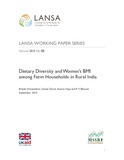| dc.contributor.author | Viswanathan, Brinda | |
| dc.contributor.author | David, Getsie | |
| dc.contributor.author | Vepa, Swarna | |
| dc.contributor.author | Bhavani, R.V. | |
| dc.coverage.spatial | India | en |
| dc.date.accessioned | 2016-08-15T15:52:43Z | |
| dc.date.available | 2016-08-15T15:52:43Z | |
| dc.date.issued | 2015-09 | |
| dc.identifier.citation | Viswanathan, B. et al., (2015) Dietary Diversity and Women’s BMI among Farm Households in Rural India, LANSA Working Paper Series 3. Brighton: LANSA. | en |
| dc.identifier.uri | https://opendocs.ids.ac.uk/opendocs/handle/20.500.12413/12161 | |
| dc.description.abstract | Undernutrition is more widespread and persistent in South Asia, including India, with higher numbers of undernourished people living in rural areas. Indian evidence often shows a weak linkage between agriculture and nutrition, though there is ample scope for agriculture to contribute towards reducing undernutrition. This study probes further to understand the linkage between agriculture, dietary diversity and women’s Body Mass Index (BMI) in rural areas of India, as few studies have looked at household nutritional intake and adult nutrition outcome in this context.
In the first part of the analysis, we find that in Indian rural areas, women in cultivator households or those who have a higher share of agricultural incomes have lower rates of undernutrition and it is the women in non-agricultural wage labour households who are worse off. To capture the specific features of agriculture, the second part of the analysis focuses on farm households, wherein dietary diversity reflecting nutrition intake is modeled at the household level, while women’s BMI-capturing nutrition outcome is modeled at the individual level. Instrumental variable quantile regression model is used to estimate the women’s nutritional status with potential endogeneity of dietary diversity.
Our findings validate once again that dietary diversity improves with:
(a) affordability coming from higher income, better wealth status, larger area under cultivation;
(b) access to better diets in a sustained manner, in the form of crop and income diversification, ownership of cows and buffaloes as well as market access to sell the crops;
(c) better awareness among households because of the presence of an educated adult member.
For improvement in an adult women’s BMI, dietary diversity matters, and an equal importance must be given to environmental conditions like better quality of drinking water, good sanitation, smoke-free cooking area and better access to healthcare facilities. Religion, caste and regional variables also play significant roles in enhancing both intakes and outcomes, while there is evidence for a limited role played by education and empowerment in an individual’s nutrition status once all these variables are controlled for. | en |
| dc.description.sponsorship | UK Aid | en |
| dc.description.sponsorship | Department for International Development (DFID) | en |
| dc.language.iso | en | en |
| dc.publisher | Leveraging Agriculture for Nutrition in South Asia (LANSA) | en |
| dc.relation.ispartofseries | LANSA Working Paper Series;3 | |
| dc.rights.uri | http://creativecommons.org/licenses/by-nc-nd/4.0/ | en |
| dc.subject | Gender | en |
| dc.subject | Health | en |
| dc.subject | Nutrition | en |
| dc.subject | Rural Development | en |
| dc.title | Dietary Diversity and Women’s BMI among Farm Households in Rural India | en |
| dc.type | Series paper (non-IDS) | en |
| dc.rights.holder | ©Leveraging Agriculture for Nutrition in South Asia (LANSA) | en |
| dcterms.dateAccepted | 2015-09 | |
| rioxxterms.funder | Department for International Development, UK Government | |
| rioxxterms.identifier.project | LANSA | |
| rioxxterms.version | NA | en |
| rioxxterms.funder.project | 752f8189-3789-4438-be29-585edbe66660 | |


